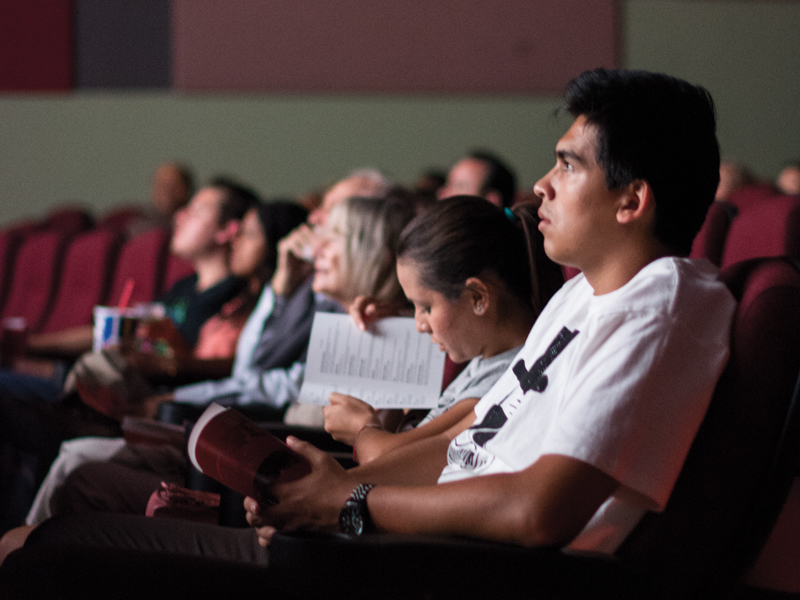
On Wednesday night, the University Village theater was rumbling, but not because of the anxiety of seeing the new “Godzilla” movie. It was because of the second annual Media and Cultural Studies (MCS) Film Festival. Situated in a single theater, it was almost a full house of aspiring directors, actors and filmmakers waiting for their work to get on the big screen, and viewers anxious to see what their peers have been working on. With a 10-minute intermission between two sets of films, the festival was well organized without people getting too bored or restless. Even though one film was unfortunately cut off, the rest of the movies played fine without any technical difficulties. For only its second year in existence, the MCS Film Festival was an exciting time for all who put in the dedicated work, and for all the viewers who got to experience it.
The night started off with MCS student Shelley Brumbaugh and professor Derek Burrill saying a few words about how excited they were to showcase incredible talent. They were followed by the co-directors of the event, Jose Gonzalez and Genevieve Newman. “We just want to get our names out there in an industry that’s already crowded,” Gonzalez said to the room. This introduction led into a short video, made to the song “Happy” by Pharrell Williams. However, instead of the usual lyric, “Clap along if you feel like happiness is the truth,” the word happiness was substituted with MCS — a fun way to show the passion of the aspiring filmmakers. It featured clips of students and professors all over campus, dancing and laughing into the camera, a representation of students truly being happy.
Out of the 32 films that were submitted to be considered, only 18 were chosen to showcase. The genres were extremely diverse, featuring documentaries, mockumentaries, horror and even animation in the running. Each crew left their mark in their films, with no submission looking exactly the same. And even though most were on average about five minutes long, they still were able to capture beautiful moments. Some were incredibly artistic, focusing on cinematography rather than dialogue. Others were emotional and focused on getting a response out of the audience, or making them aware of things around them.
One of the films that took the spotlight was Jeffrey Chang’s “Hide and Seek.” Based off a creepy story written on a Reddit forum, Chang used animation to illustrate a sense of horror in the eyes of children. When a young child plays hide-and-seek with his cousins, they come across a house with a murderous history. When he decides to hide in the house, he comes across vengeful spirits and different sorts of noises. This film was composed as a flashback with the young boy narrating it years later. With his voice sounding low and raspy, the narrator evoked a terrifying setting when he described everything from the noises he heard to his own horrified feelings. Because everything is in his own point of view, we never see any entities. Instead, we are entirely in the narrator’s eyes, and it’s nerve wracking that we don’t get a whole story until the very end.
Besides “Hide and Seek,” there was only one other film in the horror genre. “Open House,” directed by Richard Rodriguez, tackles the same issue of haunted houses, but instead of coming from a child, it is told through the eyes of a couple trying to find a new house for their growing family. Led to the house by a mysterious realtor, the home gives off a possessed vibe like “The Conjuring” or “Amityville Horror.” Even without the use of special effects or makeup, it still was utterly tense; Rodriguez managed to disturb the audience with occasional jump-scares and an unsettling music score. Even though the ending was slightly confusing, it didn’t take away from the technicals of the film. I’m not sure if Rodriguez plans to do more horror in the future, but if he does, I’ll be the first to watch it in theaters.
A documentary that especially stood out for me was “Aftershock.” Directed by Allison Moore, “Aftershock” talked about Islamophobia in the United States after 9/11. The first thing to notice in the documentary is the sound of a woman calling her husband from the plane just as it’s about to crash; just as she finishes saying “I love you,” the plane crashes into the Twin Towers, right in sync with the call. The haunting feeling just from having to connect that call with the crash stayed with me throughout the entire nine minutes of the documentary.
Using just news footage and interviews from other students, Moore created a compelling piece that illustrates hatred throughout this country. When asked why she and her group chose such a sensitive topic, she said, “We wanted to do something fresh and something you don’t see a lot of films about. Our main goal was to shine some light on a fairly sensitive issue. Going to such a diverse school as UCR has taught me that intolerance is unacceptable, so we used that as our driving force when deciding on a topic and while making the film.”
Moore’s piece was so moving that it won her the award for best documentary at the awards ceremony on the Friday after. When asked how it felt to be able to submit a piece in a festival for everyone to see, she enthusiastically said, “It feels like a proud parent hanging my gold star up on the refrigerator. It’s awesome that UCR has a film festival now. We have crazy-talented artists and storytellers here and their work deserves to be seen.”
Moore could not be any more correct. These talented students’ work deserves to be seen, and this up-and-coming festival gave them a chance. UCR is just a start, but by the look of these films, expect some of these filmmakers to be seen at Cannes or Sundance sometime soon.








